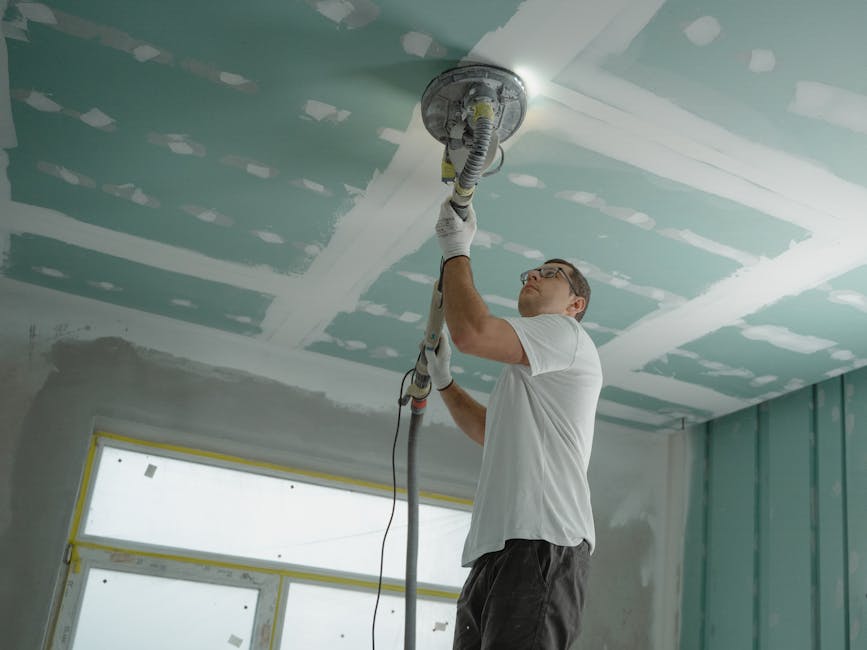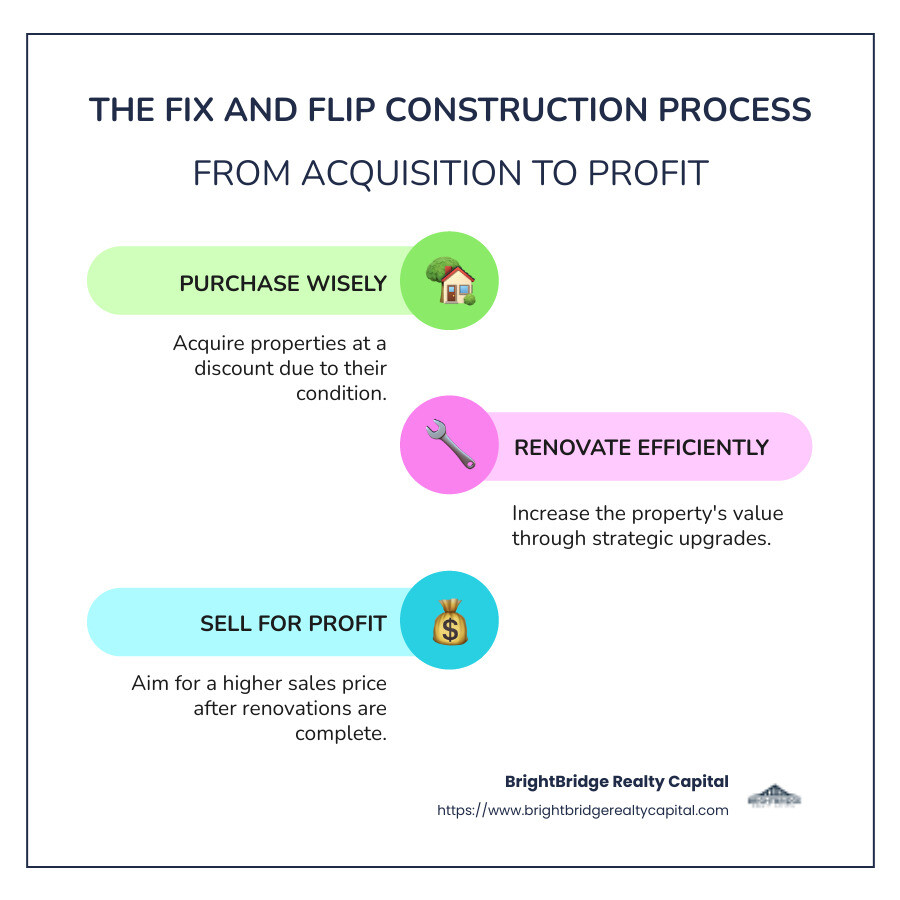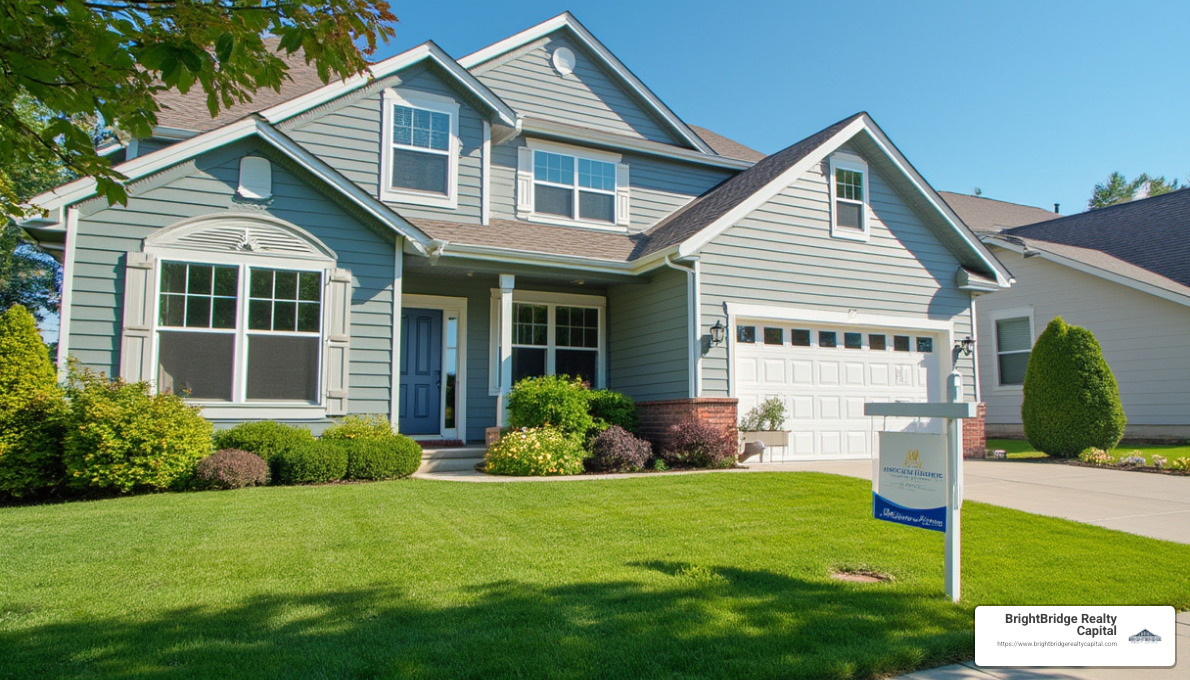From Blueprint to Profit: Managing Fix and Flip Construction

Navigating the Landscape of Fix and Flip Construction
Fix and flip construction is an exciting strategy within real estate investment. Imagine taking a run-down property, giving it a fresh face with smart renovations, and then selling it for a profit. This hands-on investment strategy is growing in popularity as investors look to capitalize on untapped property potential.
To quickly grasp fix and flip construction, consider these key insights:
- Purchase Wisely: Acquire properties at a discount due to their condition.
- Renovate Efficiently: Increase the property's value through strategic upgrades.
- Sell for Profit: Aim for a higher sales price after renovations are complete.
This method appeals to those willing to invest their time, money, and skills into changing properties. But it's not as simple as it may sound. Purchasing, renovating, and selling homes requires careful planning and financial savvy. This approach can quickly become a costly endeavor if underestimating the acquisition, renovation, and holding costs.
Stay aware of market trends and location-specific data, which can dramatically affect the profitability of a flip. New York City, with its dynamic market, serves as a prime example. Investors must steer this landscape with precision to succeed.
The journey from acquisition to sale is a rollercoaster of challenges and rewards. But with proper knowledge and strategy, investors can harness the potential of real estate to build profitable portfolios.

Fix and flip construction further reading:
Understanding Fix and Flip Construction
Fix and flip construction is a real estate investment strategy that involves buying properties, renovating them, and reselling quickly for profit. Let's break down each step to understand how this works.
Buying Properties
The first step in fix and flip construction is finding the right property. Investors look for homes that need repairs or upgrades and can be bought at a discount. The key is to find properties where the cost of purchase and renovation will be less than the potential selling price. In busy real estate markets like New York City, this requires a keen eye for undervalued properties and an understanding of local market trends.
Renovating
Once a property is acquired, the next step is renovation. This involves making strategic upgrades that increase the property's value. Common renovations include updating kitchens and bathrooms, improving curb appeal, and addressing any structural issues. The goal is to improve the property enough to attract buyers willing to pay a premium for a move-in-ready home. Efficient project management is crucial here to keep renovation costs and timelines in check.

Reselling Quickly
After renovations, the property is put back on the market. The aim is to sell it as quickly as possible to minimize holding costs, such as mortgage payments and property taxes. Pricing the home correctly and marketing it effectively are critical to achieving a fast sale. Timing is also essential; understanding the local real estate cycle can help determine the best time to list the property for sale.

This process of buying, renovating, and reselling requires a mix of skills, including financial acumen, project management, and real estate savvy. While it can be lucrative, it's not without risks. Investors need to carefully calculate costs and potential profits to ensure a successful flip. With smart planning and execution, fix and flip construction can be a rewarding way to build wealth through real estate.
Key Steps in the Fix and Flip Process
Fix and flip construction is a strategic journey that involves three main steps: purchase, renovation, and sale. Each step requires careful planning and execution to turn a profit.
Purchase
The journey begins with purchasing the right property. Investors hunt for homes that are undervalued and in need of repairs. The goal is to buy these properties at a discount, ensuring that the combined cost of purchase and renovation is less than the potential selling price.
In competitive markets like New York City, this step demands a sharp eye for opportunities and a deep understanding of local market trends. Successful investors often rely on a network of real estate agents and industry contacts to spot these hidden gems.
Renovation
Once the property is acquired, the focus shifts to renovation. This step is all about adding value. Common upgrades include modernizing kitchens and bathrooms, improving the home's exterior, and fixing structural issues.
Efficient project management is key to keeping renovation costs and timelines under control. Investors need to coordinate with contractors, manage permits, and source materials effectively. The aim is to create a home that appeals to buyers looking for a move-in-ready space.
Sale
The final step is selling the renovated property. Time is of the essence here, as holding costs such as mortgage payments and taxes can quickly eat into profits.
To ensure a quick sale, the property must be priced correctly and marketed effectively. This may involve staging the home, professional photography, and listing the property at the right time. Understanding the local real estate cycle can be a significant advantage in determining when to list the property.
In summary, fix and flip construction is a dynamic process that combines financial savvy, renovation expertise, and real estate knowledge. While the potential for profit is high, so are the risks. Successful investors carefully calculate costs and potential returns, ensuring each project is a step towards building wealth through real estate.
Financial Considerations in Fix and Flip Construction
In fix and flip construction, understanding the financial aspects is crucial for success. Let's break down the key financial considerations: acquisition cost, renovation costs, after repair value, and holding costs.
Acquisition Cost
The acquisition cost is the price you pay to purchase the property. This is the first major financial hurdle in your fix and flip project. A good rule of thumb is the "70% rule": never pay more than 70% of the property's after-repair value (ARV) minus renovation costs. For example, if a property's ARV is $300,000 and it needs $50,000 in repairs, your maximum purchase price should be $160,000. This ensures a buffer for unexpected expenses and potential profit.
Renovation Costs
Renovation costs encompass all expenses related to improving the property. This includes materials, labor, permits, and any other expenses incurred to improve the property's value. It's easy to underestimate these costs, especially for novice investors. A detailed budget and professional estimates are essential. Every dollar spent on renovation should ideally add more than a dollar to the property's value.
After Repair Value (ARV)
The ARV is the estimated market value of the property after renovation. This figure helps determine potential profit and guides your buying and renovation decisions. Accurate ARV estimation requires local market knowledge and experience. Overestimating the ARV can lead to financial losses, so it's wise to consult with real estate professionals or use reliable software tools for precise calculations.
Holding Costs
Holding costs are ongoing expenses while you own the property, including mortgage payments, property taxes, insurance, and utilities. These costs accumulate until the property is sold. In a fluctuating market, holding costs can quickly erode profits, especially if the sale takes longer than expected. Efficient project management and a strategic sales approach can help minimize these costs.
In conclusion, managing these financial considerations effectively is key to a successful fix and flip project. By carefully calculating acquisition costs, controlling renovation expenses, accurately estimating the ARV, and minimizing holding costs, investors can maximize their potential profits and reduce risks.
Common Mistakes to Avoid
Starting on a fix and flip construction project can be thrilling, but it's easy to stumble without proper planning. Here are some common pitfalls to steer clear of:
Underestimating Costs
Many investors fall into the trap of underestimating the total costs involved. It's not just the purchase price and renovation expenses; you must also account for holding costs like mortgage payments, taxes, and utilities. Overlooking these can eat into your profits. A detailed budget is crucial. Always add a contingency buffer for unexpected expenses. The goal is to sell at a higher price than your total investment.
Time Management
Flipping a house isn't a weekend project. It requires a significant time investment, from finding the right property to completing renovations and closing the sale. Misjudging timelines can lead to increased holding costs. If you have a day job, consider how you'll balance both commitments. Efficient scheduling and project management are essential. Tools like Microsoft Project or free options like SmartSheet templates can help keep your project on track.
Lack of Skills
The real money in house flipping comes from sweat equity. If you're handy with tools, you can save significantly on labor costs. However, if you're not skilled in carpentry, plumbing, or electrical work, you'll need to hire professionals, which can quickly add up. Assess your skills honestly and know when to bring in experts to avoid costly mistakes.
Market Knowledge
Understanding the local real estate market is vital. You need to know how to pick the right property, in the right location, at the right price. Overpaying for a property or misjudging its potential resale value can lead to financial losses. Research neighborhoods thoroughly and consult with real estate professionals to make informed decisions.
Avoiding these common mistakes can help ensure your fix and flip project is profitable and less stressful. By managing costs, time, skills, and market knowledge wisely, you set the foundation for success in the house flipping business.
Fix and Flip Construction Loans
When it comes to fix and flip construction, securing the right financing is crucial. Let's break down the essential aspects of these loans: loan structure, collateral requirements, and interest rates.
Loan Structure
Fix and flip loans are typically short-term, with durations ranging from 6 to 24 months. This aligns with the quick turnaround needed in flipping properties. The loan is often structured to provide funds at key stages, such as the purchase and renovation phases. This approach helps manage cash flow and ensures funds are available when needed, reducing financial strain during the project.
Collateral Requirements
In a fix and flip loan, the property you're purchasing acts as the collateral. Lenders assess the property's current value and its potential after-repair value (ARV). This ARV is crucial as it determines the loan amount. Lenders want to ensure that the property's future value will cover the loan, minimizing their risk. Detailed renovation plans and market analysis can strengthen your loan application by demonstrating the property's potential.
Interest Rates
Interest rates for fix and flip loans are generally higher than traditional mortgages. This is due to the short-term nature and higher risk associated with these loans. Rates can vary widely depending on the lender and your experience in real estate investing. While higher rates may seem daunting, the rapid turnaround and potential profit from a successful flip can offset these costs.
By understanding the nuances of fix and flip construction loans, you can better steer the financial landscape and secure the funding needed to turn your real estate vision into reality.
Next, we’ll tackle some frequently asked questions to further clarify the fix and flip process.
Frequently Asked Questions about Fix and Flip Construction
What is Fix and Flip Construction?
Fix and flip construction is a real estate investment strategy where investors buy properties, renovate them, and sell them for a profit. This process involves purchasing homes that need repairs, upgrading them to increase their value, and then reselling them. The goal is to complete this cycle quickly to maximize profit margins.
Investors often target properties that can be bought at a discount due to their condition and then focus on renovations that will significantly boost their market value. The key is to understand the local market and make smart renovation choices that appeal to potential buyers.
How Long Does It Take to Flip a House?
Flipping a house generally takes about four to six months from purchase to sale. However, the timeline can vary based on several factors such as the extent of renovations needed, the efficiency of contractors, and market conditions.
For instance, a house requiring major structural repairs might take longer than one needing only cosmetic updates. It's important to plan for potential delays, such as permit approvals or supply chain issues, which can extend the timeline. Experienced flippers often have contingency plans to handle unexpected challenges and keep the project on track.
Do I Need Cash to Flip a House?
While having cash on hand can make your offer more attractive to sellers, it's not a necessity for flipping houses. Many investors use financing options such as fix and flip loans, home equity lines of credit (HELOCs), or other lending products custom for real estate investments.
According to industry data, about 63% of house flips are purchased with cash, but that leaves a significant portion financed through other means. The choice between cash and financing depends on your financial situation, risk tolerance, and investment strategy. Understanding your options can help you make informed decisions and effectively manage your project’s finances.
By addressing these common questions, we aim to provide clarity on the fix and flip construction process. Next, we’ll explore how BrightBridge Realty Capital can support your real estate investment journey with customized financing solutions.
Conclusion
At BrightBridge Realty Capital, we understand that every real estate investment journey is unique. Our mission is to empower investors with customized financing solutions custom to their specific needs. Whether you're diving into fix and flip construction or expanding your property portfolio, we’re here to ensure you have the financial tools to succeed.
Fast Closings: One of our standout features is our ability to offer quick closings—often within a week. This speed can be a game-changer in the competitive real estate market, allowing you to seize opportunities as they arise. Our direct lending approach cuts out intermediaries, ensuring a seamless process and competitive rates.
Our expertise in real estate financing isn't just about providing funds; it's about partnering with you to steer the complexities of the market. We offer guidance and support every step of the way, ensuring that your investment strategy aligns with your financial goals.
Ready to take the next step in your real estate investment journey? Explore our financing options and find how we can help you turn your blueprints into profit.


